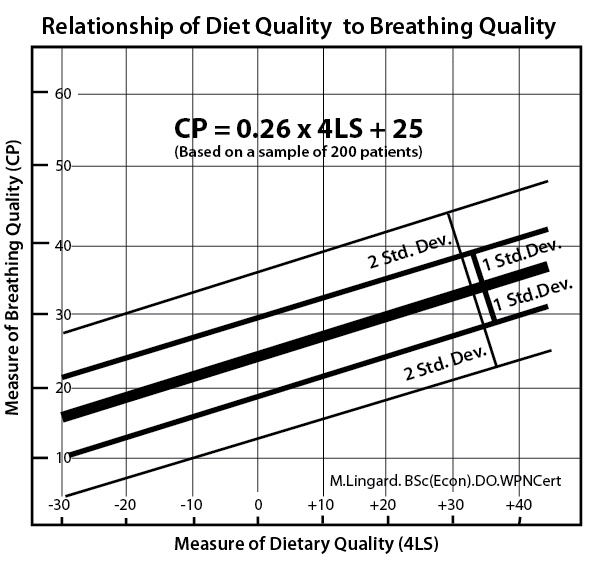
The above graph shows the relationship between the quality of your diet and your breathing.
Below are some basic ways of improving your breathing, but before you start you may want to check the quality of your breathing.
The measure used is based on the Internationally accepted Buteyko Method measure, the “Control Pause” HERE
The Basics of Better Breathing & Better Health
- The first step is learning the fact that most of us suffer some degree of CHHV or chronic hidden hyperventilation, over-breathing in simple terms.
- Secondly, CHHV makes us ill! Anything from low energy, and poor sleep to serious health problems such as asthma, hypertension, sleep apnoea, or panic attacks.
- Most of us arrived at this state because of the many stressful events in our lives, emotional, physical, illnesses, chemicals, or whatever. Any stress triggers a primitive response called the “Fight or Flight Syndrome” that once protected us from saber-toothed tigers but today is not so useful and more often has an adverse effect on our health.
- The Fight or Flight response produces over a thousand physiological changes in our bodies preparing us for emergency action, all but three of these responses we have little or no control over, e.g. histamine production, adrenaline production, corticosteroid production, etc.
- We can however take conscious control over three of them; our muscle tension, our breathing, and our mental tension. The neat thing is that once we start to take control over muscle tension, mental tension, and our breathing all the others are reduced.
- There is a very detailed physiological explanation for the benefits of better breathing that you can learn about later. Right now all you need to know is that CHHV causes us to lose carbon dioxide (carbon dioxide is far from being the deadly gas many of us have been led to believe, it is the essential stuff of all living things, we would be dead without it! (We need around 6% in our bodies to function well)
- Carbon dioxide is so important to our life, our breathing is governed by the level of carbon dioxide in our blood, and not oxygen. Receptors in the brain measure the level of carbon dioxide and adjust our breathing accordingly, if too much we are made to breathe more to “wash out” the excess, if too low we are made to breathe less to conserve it.
- With CHHV our receptors have been set at too low a level of carbon dioxide and much of the breath training will be to correct this, returning them to normal.
- Low carbon dioxide levels cause: a) Spasm of smooth muscle wrapped around all hollow organs in our body, blood vessels, airways, bladder, gut, etc. b) The blood’s ability to deliver oxygen to all our tissues is impaired and c) the pH, or acid/alkalinity of the body is changed affecting every chemical reaction in our bodies adversely.
- There are many other effects associated with poor breathing but you can learn about them later.
- So correct your breathing, if you need to! First, you need a measure of your breathing. This is based on two very simple checks you do yourself, namely, the control pause and pulse measurements.
- The control pause (CP) is a measure of your maximum COMFORTABLE breath hold in seconds after a normal exhalation while at rest. Effectively it measures how well your body is oxygenated, if you’re well oxygenated you don’t need another breath for some time, if very poorly oxygenated you will want to take the next breath almost immediately.
- The Pulse is measured on your wrist or neck by counting the number of beats in 15 seconds and multiplying by 4 to give the number of beats per minute.
- The table below gives a rough guide as to how good or bad your breathing is related to your CP, your pulse may add more information about this.
| Control Pause | CO2 | Your Breathing State |
| 45-60 seconds | 5 – 6 % | Excellent normal breathing. |
| 35-45 seconds | 4.5 – 5% | Good but slight over-breathing |
| 25-35 seconds | 4 – 4.5% | Moderate hyperventilation |
| 20-25 seconds | 3.5 – 4% | High hyperventilation affects your health |
| 15-20 seconds | 3 – 3.5% | Serious hyperventilation |
| 10-15 seconds | 2.5 – 3% | Severe hyperventilation |
| < 10 seconds | < 2.5% | Critically poor breathing |
As you improve your breathing you will find your CP increases and your pulse decreases for a while until your normal base level pulse rate is reached.
Start Training:
Disclaimer: Please note, that breathing has a powerful effect on our entire body & therefore any exercises should be done with caution. If you have a history of any serious condition including, diabetes, heart disease, hypertension, psychotic conditions, severe asthma, etc. you are advised to only do breath training with the support & supervision of your doctor, health professional or Buteyko Educator. This also applies to anyone with a CP of under 15 seconds.
Record your training exercises as below;
Date Time CP Pulse RB CP Pulse
1/2/22 9am 26 80 5min 29 76
- Make an effort to always breathe through your nose, breathing in and out through it.
- If you have a stuffy or blocked nose: Take a breath in then out and gently hold your nose while nodding ten times keeping your mouth closed. Release your nose and breathe in through your nose. Repeat as necessary.
- Check how you are breathing; hold one hand on your chest and the other on your belly, which hand is being moved the most? Try to get all the movement low down where your diaphragm is.
- Measure your CP and Pulse. Sitting down and relaxed, keep your mouth closed, take a breath in through your nose, and gently hold your nose and hold your breath until you feel the need to breathe in, release your nose and breathe in through your nose. With a watch or timer check how long you held your breath, that was your Control Pause (CP). It is your maximum comfortable breath-hold, at rest, after exhaling. Find your Pulse on your wrist check how many beats you feel in 15 seconds and multiply by four to give your Pulse rate in beats/minute.
- Now practice RB. RB stands for Relaxed or Reduced breathing. Start by simply relaxing, do not try to reduce breathing at this stage.
- Relax every muscle in your body, and be “soft like a cloth!”
- Only breathe through the nose, keep your mouth shut.
- Try to keep the daily mental stresses out of your thinking by occupying your mind with something calming like imagining a garden, seashore, or desert island.
Relaxed Breathing
- Sit upright with a straight back and both legs placed on the floor.
- Close your eyes.
- Sit like this, just learning to relax thoroughly for two to five minutes then open your eyes and wait for another minute while resting, to let your breathing return to its new normal.
- Now measure your CP and Pulse again.
- If you have succeeded in doing this exercise well, your CP will be higher and your Pulse may be lower or the same. This will mean you are breathing less.
- That was your first exercise in resetting your carbon dioxide receptors.
- Repeat this exercise three or four times a day.
Visit the website section Courses & Training for other options such as 1-2-1 Zoom training, a full Podcast Training Course, etc.
St Bridget, Hawkhurst, Kent UK www.TheBreathConnection.com

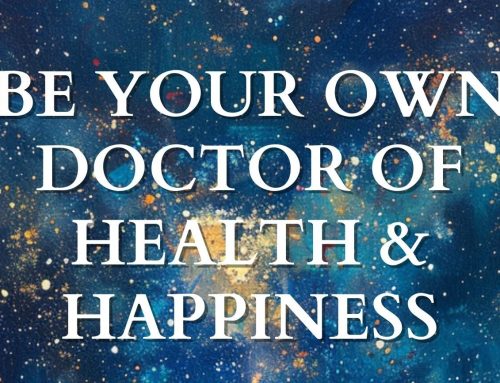

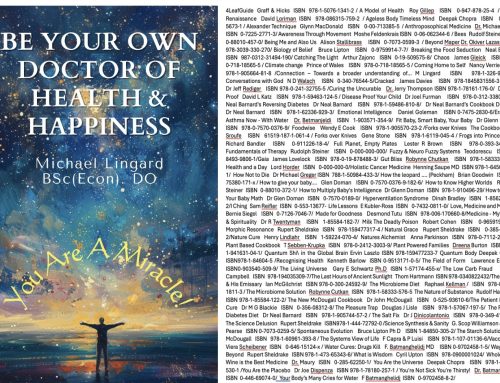
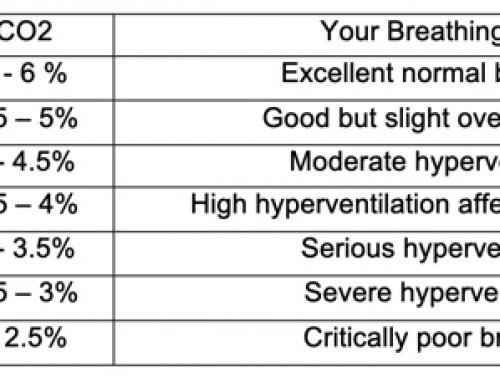
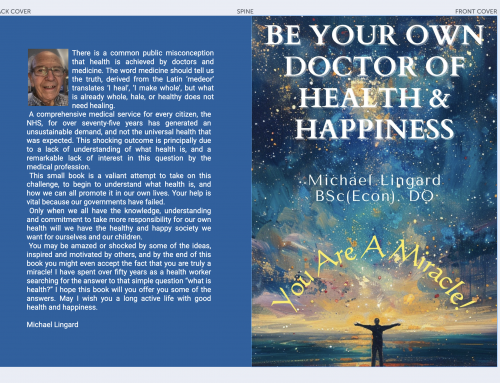
Leave A Comment